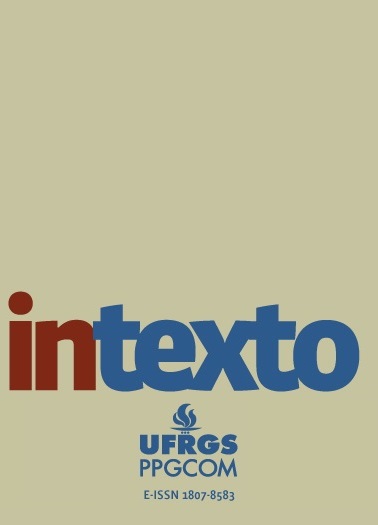Metanarrative, fiction and non-fiction in Jafar Panahi's Taxi
DOI:
https://doi.org/10.19132/1807-8583202152.92653Keywords:
Metanarrative. Fiction and nonfiction. Iranian films.Abstract
The aim of this article is to discuss how contemporary cinema has been exploring the tension in the boundaries between fiction and nonfiction through the strategic use of metanarrative devices. Metanarrative exposes and brings into question the inevitable processes of fictionalization of the narrative and the intention to offer through it authentication proofs of the real, supposedly and dialectically constructed in the bordering relations of the subjective interference of an enunciating instance. Iranian director Jafar Panahi’s cinematography, well known for its self-reflexivity, propounds the idea that art should look inward and recognize itself as discourse. We analyze his 2015 film Taxi, whose choice of language and discourse is the result of the operational constraints to which Panahi was subjected, as he was forbidden by the Iranian justice to make cinema. Seeking to present ordinary life situations in Tehran, the director turns on a camera inside a taxi, where he plays the role of the driver while having conversations with random passengers. We conclude that Panahi makes cinema in order to bring that act into question and to position it as a political act. His work shows us the impossibility of limiting the nature of the audiovisual medium and, by extension, the very principles regulating filmmaking in Iran, and denounces the repressive system which dominates it. in the coon film pr.
Downloads
References
AMARAL, Aline Moreira do. A representação da mulher em O círculo de Jafar Panahi: o Irã, o Islã e o cinema (1979-2001). 2015. Dissertação (Mestrado em História) - Programa de Estudos Pós-Graduados em História, Pontifícia Universidade Católica de São Paulo, São Paulo, 2015.
ANDERSON, Perry. As origens da pós-modernidade. Rio de Janeiro: Jorge Zahar, 1999.
ANDRADE, Ana Lúcia. O filme dentro do filme: a metalinguagem no cinema. Belo Horizonte: Editora UFMG, 1999
AUMONT, Jacques et al. A estética do filme. Campinas: Papirus, 1995.
BARTHES, Roland. Análise estrutural da narrativa. Petrópolis: Vozes, 2008.
BAZIN, André. O cinema: ensaios. São Paulo: Brasiliense, 1991.
BERNARDO, Gustavo. O livro da metaficção. Rio de Janeiro: Tinta Negra, 2010.
CAMARGOS, Marcia; CARRANCA, Adriana. O Irã sob o chador: duas brasileiras no país dos 96 aiatolás. Rio de Janeiro: Globo, 2010.
COSTA, Bruno. Paixão e nostalgia pelo real. In: ENCONTRO DA ASSOCIAÇÃO NACIONAL DOS PROGRAMAS DE PÓS-GRADUAÇÃO EM COMUNICAÇÃO, 19., 2010, Rio de Janeiro. Anais [...]. Rio de Janeiro: PUC-RJ, 2010. p. 1-13.
FIGUEIREDO, Vera Lúcia Follain de. Novos realismos, novos ilusionismos. In: GOMES, Renato Cordeiro; MARGATO, Izabel (org.). Novos realismos. Belo Horizonte: UFMG, 2012. p. 119-132.
GAUDREAULT, André; JOST, François. A narrativa cinematográfica. Brasília: UnB, 2009.
GOMES, Renato Cordeiro. Por um realismo brutal e cruel. In: GOMES, Renato Cordeiro; MARGATO, Izabel (org.). Novos realismos. Belo Horizonte: UFMG, 2012. p. 71-90.
HUTCHEON, Linda. Poética do pós-modernismo: história, teoria, ficção. Rio de Janeiro: Imago, 1999.
HUTCHEON, Linda. Narcissistic narrative: the metafictional paradox. Waterloo: Wilfrid Laurier University Press, 1980.
JAGUARIBE, Beatriz. O choque do real: estética, mídia e cultura. Rio de Janeiro: Rocco, 2007.
JAMESON, Fredric. Pós-modernismo: a lógica cultural do capitalismo tardio. 2. ed. São Paulo: Ática, 1997.
LOPES, Denílson. Estéticas do artifício, estéticas do real. In: GOMES, Renato Cordeiro; MARGATO, Izabel (org.). Novos realismos. Belo Horizonte: UFMG, 2012. p. 147-162.
LYOTARD, Jean-François. A condição pós-moderna. 8. ed. Rio de Janeiro: José Olympio, 2004.
MELEIRO, Alessandra. O novo cinema iraniano: arte e intervenção social. São Paulo: Escrituras, 2006.
METZ, Christian. Linguagem e cinema. São Paulo: Perspectiva, 1980.
MOUSINHO, Luiz Antonio; OLIVEIRA, Rayssa Mykelli de Medeiros. Os dispositivos metaficcionais e a imbricação de forma e conteúdo em O artista. Revista Livre de Cinema, João Pessoa, v. 5, n. 1, p. 4-15, 2018.
TÁXI Teerã. Direção de Jafar Panahi. Teerã: Jafar Panahi Films Production, 2015. 1 disco (82 min), son., color.
ZIZEK, Slavoj. Bem-vindo ao deserto do real! cinco ensaios sobre o 11 de setembro e datas relacionadas. São Paulo: Boitempo, 2002.
Downloads
Published
How to Cite
Issue
Section
License
Copyright (c) 2021 Pedro Piccoli Garcia, Fabiana Quatrin Piccinin

This work is licensed under a Creative Commons Attribution-NonCommercial 4.0 International License.
The copyright of works published in this journal belong to the authors, and the right of first publication is conceded to the journal. Due to the journal being of open access, the articles are of free use in research, educational and non-commercial activities.
Therefore, the journal uses the License Creative Commons Attribution (CC BY-NC 4.0), which allows sharing of work with acknowledgment of authorship.
Self-archiving (repository policy): authors are allowed to deposit all versions of their work in institutional or thematic repositories without embargo. It is requested, whenever possible, that the full bibliographic reference of the version published in Intexto (including the DOI link) be added to the archived text.
Intexto does not charge any article processing fees (article processing charge).















